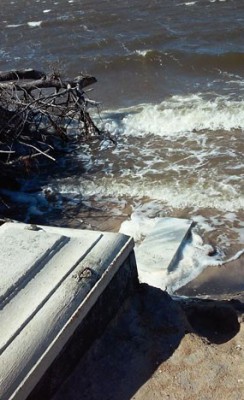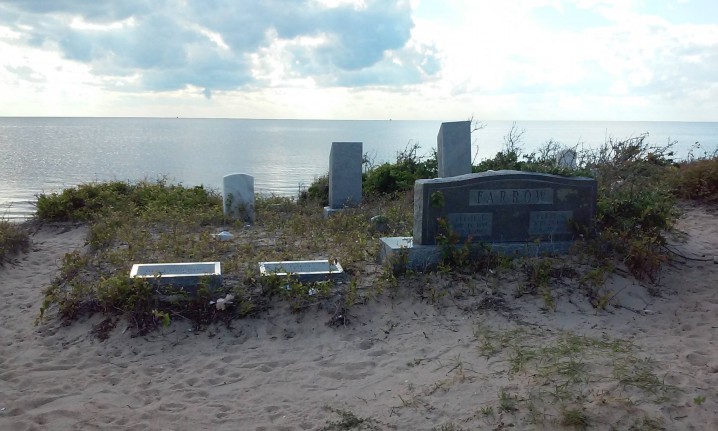Reprinted from the Island Free Press

SALVO — Efforts to help repair and save the Salvo Day Use Cemetery – also known as the Midgett Cemetery – are heating up as community members recognize the current dire state of the site, as well as the devastating effects the next major hurricane or storm could inflict on the already troubled area.
Supporter Spotlight
The cemetery, which is on National Park Service land within the popular Salvo Day Use Area just south of the tri-villages of Salvo, Waves and Rodanthe, has been battered by storms and erosion, particularly for the past five to 10 years, and has rapidly deteriorated to the dismay of the descendants of the islanders who are buried there.
Headstones have broken, washed away or have been removed by concerned family members who worry they could disappear altogether, and tombs are becoming exposed as the sound front area steadily recedes from a regular battering of high water and waves.
Tri-village community members have been fighting for a long time to address the issue, but it’s quickly becoming a race against time to raise the roughly $120,000 required to protect and save the site.
“If you look at pictures [of the cemetery] from the 1970s until now, it’s clear that it has gotten bad,” says Jenny Creech, president of the Hatteras Island Genealogical and Preservation Society. “Even since this past December, you can see a significant change.”
Creech has become the point person for the effort to raise funds and find ways to address the problem, and has created a GoFundMe page to reach out to the community and ask for help. She was asked last year by residents to get involved.
Supporter Spotlight
“I knew it was in bad shape, but was under the same conclusion as everyone else – that it was Park Service property, and not private property. It became a big issue for me, and I want to get more people involved,” says Creech.
And while it’s a common misconception that the cemetery is owned by the National Park Service and should be eligible for federal funding, the fact is that the site is actually private property and must therefore be funded through community donations.
“[The government] can’t step in,” says Creech, “But I’ve been working with Dave Hallac of the National Seashore, and whatever we decide to do, he’s willing to help us.”
It’s easy to see why so many people believe that the cemetery is on Park Service land. Surrounded by the Salvo Day Use Area – a popular park-managed spot for windsurfers, kite boarders, fishermen and everyday beach fans – the cemetery is effectively bordered by undeveloped park property.
However, according to Creech, the site was deeded as in-holding when the surrounding property was sold to the National Park Service and belongs to the community of Salvo. Therefore, it’s the descendants of the interred who actually own the property.
And in a small community like Hatteras Island, the descendants are numerous.
“My own great-great grandfather and great-great-great grandfather are both buried there,” says Creech. “And we want to get our generation more involved and ready to help.”

The gravesites within the cemetery – those that are still intact and standing – are effectively a who’s who list of generations of island families. Familiar names such as Gray, Williams, Midgett and Farrow are all present, with headstones that date back to the mid-to-late 1800s.
Essentially, there are possibly hundreds of area residents who have a personal stake in the cemetery’s survival – and that doesn’t include long-time visitors who are saddened to see the continual decay of the gravesites at their favorite sound side beach.
“We have more and more visitors there every year, and I’ve talked to several people while I was taking photos that have said ‘We’ve been coming here for years, and it’s such a beautiful place, and we want to help if we can,’” says Creech.
And once people understand that it’s not in the Park Service’s hands but the community’s hands to save the cemetery, folks are stepping up to contribute. But there’s still a long way to go to reach the $120,000 mark.
The figure was reached after a conversation with a contractor several years ago, so it may need to be adjusted for any present-day inflation. The money will pay for a vinyl bulkhead – which will last much longer than a wooden one – as well as a wall of rocks to help with absorbing the wave energy. In addition, permits can be obtained with the funds to complete the project, and a fence or barrier could be installed to keep foot traffic away from the gravesites.
“The Rodanthe-Waves-Salvo Civic Association will be our umbrella group because they are a non-profit [organization],” says Creech. “This way, everything is tax deductible and is on the up and up.”
Once all the money is raised, the group can start taking bids from contractors, she adds.
And so the effort to raise awareness, and get the community involved in funding, is on.
You can donate at the Gofundme page. Checks can also be mailed to the RWS Civic Association, Attn: Gene Stoel, PO Box 323, Rodanthe, NC 27968. Checks should be made payable to the Rodanthe-Waves-Salvo Civic Association, with “Salvo Cemetery” written in the memo line.
A Facebook group has also been established to share images, stories, and information on the cemetery, featuring both recent and more dated photos. The page is a striking testament to just how much the area has changed.
“There’s a lot to do, and a lot of money to raise,” says Creech. “My biggest concern is that if we have one bad storm this year, it’s going to do some really bad damage.
“We’re definitely racing against the clock on this.”
Learn More
This story is provided courtesy of the Island Free Press, a digital newspaper covering Hatteras and Ocracoke islands. Coastal Review Online is partnering with the Free Press to provide readers with more environmental and lifestyle stories of interest along our coast. You can read other stories about Hatteras and Ocracoke here.







